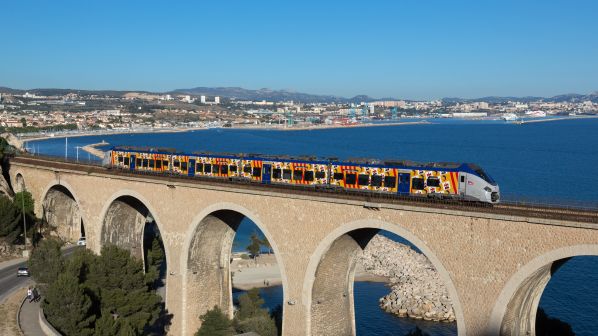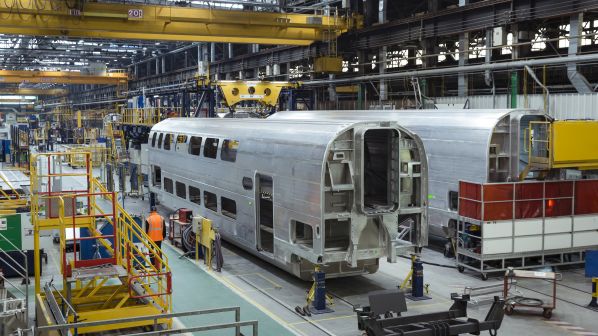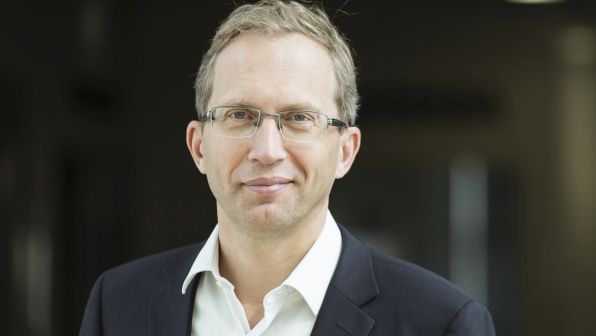ALMOST two years to the day that the European Commission (EC) quashed plans by Alstom and Siemens Mobility to merge their railway supply and manufacturing activities, another tie up between two of the industry’s traditional big three suppliers was officially completed on January 29.
This time it is Alstom and its long-time rival, Bombardier Transportation, which together are the now world’s second largest railway equipment manufacturer behind China’s CRRC, with combined annual sales of €16.4bn in their latest annual results.
The deal was announced on February 17 2020, and according to Alstom chairman and CEO, Mr Henri Poupart-Lafarge, who was speaking to IRJ in his first media interview since the deal was finalised, negotiations have proceeded “very fast.”
“I believe it is a record to have closed such a complex deal in less than a year,” Poupart-Lafarge says.
Unlike the aborted Alstom-Siemens merger, Alstom is acquiring Bombardier Transporation outright. The deal is worth approximately €5.5bn. Under the agreement, Caisse de Depot et Placement du Quebec (CDPQ), which held a 32.5% stake in Bombardier Transportation, will become Alstom’s largest shareholder with 17.5% of capital. Alstom successfully realised a €2bn capital raise in December while CDPQ will reinvest €2.6bn in Alstom, which will go towards funding the acquisition. Bombardier will invest €500m. Alstom also successfully carried out a €750m senior bond issuance at 0% fixed coupon on January 11, which will finance part of the acquisition. Bouygues will remain a shareholder in Alstom with around 6% of capital.
To appease EC anti-trust concerns, which were made public in June, Alstom is set to divest Bombardier’s very-high-speed segment to Hitachi. The two companies partnered in 2010 to supply ETR 400 trains to the Italian market and more recently Spain, with 23 trains currently under construction for new operator Ilsa. Bombardier and Hitachi were also bidding jointly for Britain’s HS2 rolling stock tender.
Alstom is also set to let go of its Coradia Polyvalent platform and its Reichshoffen factory in France, Bombardier’s Talent 3 platform and related activities at Hennigsdorf, Germany, a small segment of what is a huge site according to Poupart-Lafarge, and some interfaces and products from Bombardier’s onboard signalling units and train control management systems (TCMS). Poupart-Lafarge confirmed that after contact from “a number of potential suppliers,” Alstom is in exclusive negotiations with Škoda over these sales, a move that will dramatically increase the Czech supplier’s reach in the European market.
“There have been no further discussions with the EC on the scope of these divestments,” Poupart-Lafarge says. “We have not yet implemented them [the sales]. Sometimes small deals take longer than big deals, and it is not a condition of closing our deal. It takes more time because of Covid, so some of the buyers are taking a little longer in their decision.”
Following the takeover, Alstom now has an order backlog of around €68bn. In its nine-month results published on January 19, the French supplier confirmed a backlog of €40.1bn with orders totalling €4.5bn in the first nine months of the financial year to December 31, and €1.836bn in the third quarter. Bombardier Transportation also reported a €28.1bn order backlog in its third quarter results published on November 5. Third quarter revenue was €2.12bn. However, financial difficulties at its parent company, which is also in the aviation sector, became apparent in recent years, which has placed Transportation under pressure.
Bombardier’s falling standing in the overall global rail market has also become evident. From leading SCI Verkehr’s index of the world’s largest railway equipment suppliers a decade ago, Bombardier slipped to fourth place in the 2020 survey.
“Bombardier Transportation is a global company and they are bringing to us a number of assets around the world.”
Henri Poupart-Lafarge, Alstom chairman and CEO
Reports of the company’s failure to pay suppliers on time have been commonplace in the market in recent years. There were also delays to deliveries of some high-profile fleet orders in Germany, Britain, the United States and Canada as well as technical difficulties with the supply of double-deck tilting trains to Swiss Federal Railways (SBB), all of which have undermined its reputation.
Poupart-Lafarge says that following the failed merger of Alstom and Siemens, and a possible merger between Siemens and Bombardier, which he says was explored, Bombardier approached Alstom over a straight disposal of the Transportation business in the summer of 2019.

Poupart-Lafarge says this was the first time a direct sale was proposed. And while Bombardier Transportation’s underperformance was a concern going into the deal, Poupart-Lafarge says it is the result of a “lot of different situations” with problems on projects “across the board.” He says there is “no silver bullet” available for resolution. However, he cites managerial issues as an overarching cause.
“They have been under huge pressure for years because of the difficulties of the Bombardier Group,” Poupart-Lafarge says. “I think what is required is stabilisation. We need to help from a technical standpoint where there are still some technical issues which need to be solved and our experts will definitely help them.
“We need to get some stability with various customers, stakeholders, and suppliers. I am not going to promise an immediate resolution - I have been a CEO long enough to know that you won’t solve all the problems on day one. But at least you can have intelligent dialogue with the customers, the operators, and can redesign the planning process. You then need to keep to your commitments, because the one thing that operators hate is when you keep changing your plans.”
A decade in the making
As well as Bombardier’s recent travails, Poupart-Lafarge says the acquisition reflects a wider desire for consolidation to ward off the threat from non-European competitors. Indeed, he says the first such discussions over such an arrangement among the big three happened around a decade ago and fulfils a long-term objective to deliver a truly global capability in railway industry supply.
The tie-up with Siemens had a similar objective. Under that deal, Poupart-Lafarge says Alstom was effectively acquiring Siemens Mobility, with Alstom in turn acquired by Siemens Group. The primary aim was to reinforce Alstom’s digital signalling activities. However, this raised anti-trust concerns at the EC, which downplayed the threat from Chinese competitors in the European market cited by Alstom and Siemens as the rationale for the deal. The EC ultimately concluded that the merger would have significantly reduced competition in signalling as well as high-speed rolling stock in the European market and blocked it.
“But if you took that part [the signalling] out, then the merger made little sense,” Poupart-Lafarge says.
With Bombardier Transportation, Poupart-Lafarge says it is a different story. “Bombardier Transportation is a global company and they are bringing to us a number of assets around the world,” Poupart-Lafarge says. “They have a particularly strong presence in Mexico and China, so I think it is more of a case of industrial and geographic complement. In terms of signalling technology, they are bringing some interesting technologies, in particular the German interlocking technology, which will allow us to enter the German trackside market. But it is fair to say, they are smaller than Siemens in signalling, which was one of the issues between us, Siemens and the EC.”
While the deal with Bombardier is much simpler, Poupart-Lafarge says the experience with the failed Siemens merger helped this process. He says the EC was familiar with the file and the rail industry, whereas previously they had not dealt with a similar sized acquisition for 20 years. Likewise, Alstom knew what to expect from this process. And even in the difficult situation presented by Covid-19, where much of the work took place remotely, a situation Poupart-Lafarge likens to “a marriage where you cannot touch one another,” he says it went really smoothly and proceeded just as fast as it would have done without restrictions.
As the focus moves from acquisition to integration, the Covid situation is likely to continue to present difficulties in the short-term as the new company takes shape and teams align. The Bombardier brand will disappear from the rail market but as Poupart-Lafarge is keen to stress, it is not a question of replacing Bombardier products with Alstom products but marrying the best of the two.
Poupart-Lafarge says the first step is to align the new company, so it can continue to deliver to existing customers without disrupting project execution and commercial momentum. “Then we will align our products and will make sure that we will take the products which are most suitable for the customer,” he says.
For example, Bombardier’s Traxx locomotive platform is in widespread use in Europe whereas Alstom has no real footprint. However, in India and Central Asia, Alstom has a stronger locomotive presence. “We will have to make sure that elements in the locomotives are standardised, so it is one platform,” Poupart-Lafarge says. “It won’t be a case of picking and choosing one Alstom and one Bombardier product in our portfolio.”
Likewise, for LRVs, Alstom’s Citadis platform is the standard in France and has been used on other new build projects around the world, from Jerusalem to Dublin, and Dubai to Rio de Janeiro. Poupart-Lafarge says Bombardier LRVs have been deployed more on legacy networks, particularly in Germany. It has also had notable success in Australia and Canada. “Bombardier’s solutions are more suitable for the markets they are already in, but we need to make sure in terms of components such as motors, bogies and so forth that we align the platforms,” Poupart-Lafarge says.

“We have already been looking at the full portfolio and it will not be so complex to make decisions, but it will take some time until it becomes one portfolio. We don’t have to kill a particular product per se, it will be an addition, with the ultimate goal of better serving customer needs and improving our competitiveness.
“A good sign will be when you have this tram manufactured by what was Bombardier, but it has a traction system produced in Tarbes, Alstom’s traction site. It will mean that we have standardised enough of the product.”
Poupart-Lafarge adds that the integration process will begin as the new company bids for new tenders. He says it will offer the company clear cost benefits by sharing the same overhead and structures. It will also seek efficiencies by not developing the same product twice and sharing and adding improved machine tools.
This is particularly apparent in the Chinese market where Bombardier has a successful joint venture with CRRC Sifang Qingdao. The company employs 8000 people and has produced 4700 passenger cars, 580 electric locomotives and more than 3000 metro cars, automated peoplemovers and LRVs. It also provides maintenance services and has supplied signalling for the Chinese high-speed network and propulsion equipment and signalling systems for 30 Chinese cities through other joint ventures. Alstom also has a presence in the Chinese signalling market through a joint venture with CRSC as well as a traction joint venture, and Poupart-Lafarge says that as well as the domestic market, the expanded Chinese company could serve to supply sub-components to other projects around the world.
“It is always difficult to know which markets will be first, so we need to be there. If you’re not everywhere you take the risk of missing an evolution.”
However, Poupart-Lafarge says the strategy won’t mean the closure of plants. He says the objective of the merger is for the expanded company to retain a local presence in markets throughout the world. He points to Mexico as an example where Alstom has gained a plant from Bombardier.
“The Mexican president [Mr Andres Lopez Obrador] has said they are launching a new project where they want the equipment to be manufactured in Mexico,” Poupart-Lafarge says. “There is no way we are going to close the factory in Mexico because we want to have access to the Mexican market. It is suboptimal from a management standpoint, but we need to live with a vast network of factories.”
In countries where both companies have factories, it is likely that there will be specialisation. This opens the debate between which of the Alstom or Bombardier industrial strategies the new company will follow. Historically Alstom tends to specialise by product. For example, La Rochelle manufactures LRVs and high-speed trains and Valenciennes metro trains. Bombardier’s sites in Germany by contrast tend to specialise by value chain, with sites manufacturing bodyshells, and others only doing fitting.
“We need to think about the two models, there are pluses and minuses in both,” Poupart-Lafarge says. “If you are to build the bodyshells as a separate product, you are better off putting it all in a single site and automating as much as you can. We know that Bombardier is suffering a lot because the bodyshells are not the same as each other. But it is not black and white, which is why both companies followed their respective strategies. We will study that and there will probably be some specialisation, but it will take time. It will probably be four or five years before we arrive at this point.”
Lead innovator
Enhancing the company’s global presence is key to Poupart-Lafarge’s strategy for Alstom to become the leading innovator in the market. He says it is imperative that the company has the necessary cash flow and scale to respond to opportunities whenever and wherever they arise. The Bombardier Transportation acquisition accelerates this process.
Indeed, while it is unlikely Alstom can compete solely on cost with Chinese rivals, Poupart-Lafarge says the “true battle” is in innovation as climate-conscious customers demand more energy efficient, quieter, and cleaner railway transport solutions.
For example, Alstom is seeking to expand its capabilities in battery-powered rolling stock. It is already trialling a new battery traction system developed in Tarbes in France and is supplying 11 Coradia Continental battery-EMUs to Germany.
Poupart-Lafarge also points to the example of Alstom’s Coradia iLint, the world’s first hydrogen train, which was launched in Germany, a world leader in hydrogen technology. The train has since been tested in Austria and the Netherlands with countries around the world now actively considering the technology. Other suppliers have also announced projects to develop their own hydrogen platforms, reinforcing the view that the technology has a role to play in future rolling stock.
“We know there is a transition in the mobility sector, and we know that some markets will be quicker to achieve this than others,” Poupart-Lafarge says. “It is always difficult to know which markets will be first, so we need to be there. If you’re not everywhere you take the risk of missing an evolution.”
As for the current and medium-term prospects for the market, Poupart-Lafarge is unsurprisingly optimistic. While Covid undoubtedly had an impact in 2020, he says several postponed projects mean that there is a strong project pipeline. Upcoming government stimulus plans will also boost demand. And with Covid-19 vaccines offering a way out of the crisis, he says attention will return to the climate challenge, a situation which offers a real opportunity for rail.
He is particularly encouraged by Europe’s Green Agenda and upcoming projects in markets such as Portugal and Romania. In the United States, the new Biden administration, and the prospect of the federal government restoring funding for urban rail projects, is a cause for optimism.
However, Poupart-Lafarge says the first priority is to stabilise the new company, a process for which after nearly 18 months of negotiation and a decade of talking, he is excited to get started. “This is something you do once every decade, if not more,” he says. “You don’t need to rush, rush, rush. You need first to make it a success. So, standardise and innovate. That will be our passport for growth.”

